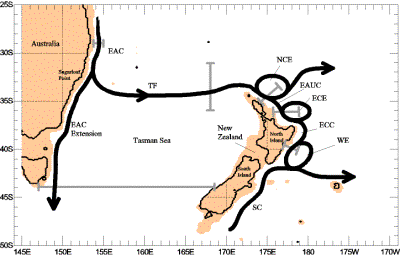Final Project Summary
Topic Area
East Australian Current
LEUT Robyn Phillips, RAN
The East Austrlalian Current affects both Australia
and New Zealand and involves warm core rings, instability theory and sub-tropical
fronts.
The East Australian Current (EAC) is a sub-tropical
western boundary current that is fed by the South Equatorial Current via
the Coral Sea. It is the weakest western boundary current with highly variable
transports. The narrow surface current flows southwards along the outer
shelf and continental slope down to a depth of around 500m and with speeds
of up to 5kts. About two thirds of the current separates from the coast
near Sydney and proceeds eastwards as the Tasman Front, with the remainder
continuing south. The seasonal cycle of the EAC is more pronounced that
other mid-latitude western boundary currents.
The EAC creates mostly anticyclonic warm core eddies
via retroflection near Sydney. The average width is 200km and the depth
of influence is around 500m. The eddy mass transports can be several times
larger than the mean EAC.
The EAC continues around New Zealand in the form of
several currents and quasi-stationary eddies before the majority of the
current separates from the land and continues eastwards into the Pacific
Ocean.
The NRL Layered Ocean Model was used to examine the
dynamics of the EAC in the Australian and New Zealand region. The following
is a summary of the results:
¬…Flow
features are not functions of resolution.
¬…Upper-ocean-topographic
coupling via baroclinic instabilities goversn the phase and amplitude of
the mean meanders in the Tasman Front.
¬…The
shape of the wind stress curldetermines
the separation points of the currents.

Figure 1. The East Australian Current System. EAC = East Australian Current, EAUC = East Auckland Current, ECC = East Cape Current, TF = Tasman Front, SC = Southland Current, NCE = North Cape Eddy, ECE = East Cape Eddy, WE = Wairarapa Eddy.
Tomczak,
M., and J.S. Godfrey, 1994: Regional Oceanography: An Introduction.
Brink,
K.H., and A.R. Robinson, 1998: ’ÄúAustralia's Shelf Seas: Diversity
and Complexity’Äù. The Sea,
Volume 11, 933-965.
Ridgway,
K.R., and J.S. Godfrey, 1997: ’ÄúSeasonal Cycle of the East Australian
Current’Äù. Journal of Geophysical Research,
Volume 102, No. C10, October 15, 22921-22936.
Nilsson,
C.S., and G.R. Cresswell, 1981: ’ÄúThe Formation and Evolution of East
Australian Current Warm-core Eddies’Äù. Progress in Oceanography,
Volume 9, 133-183.
Tilburg,
C.E., H.E. Hurlburt, J.J. O’ÄôBrien, and J.F. Shriver, 2001: ’ÄúThe Dynamics
of the East Australian Current System: The Tasman Front, the East Auckland
Current, and the East Cape Current’Äù. Journal of Physical Oceanography,
October 2001, 2917-2943.
| This is a government-maintained internet site. Please read the U.S. Navy web page disclaimerand the dislaimer regarding external links. |
|